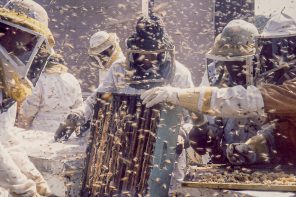By : Kim Flottum
I’ve been attending one or the other, and sometimes but rarely both, of the National meetings in January almost every year I’ve been here. This year I traveled to Phoenix to attend the American Honey Producers meeting. Kathy and Jean went to the American Beekeeping Federation meeting in Myrtle Beach, so we had them both covered.
I’ve tried doing a booth for our books and the magazine a couple of times at these meetings, but mostly I send ahead a bunch of magazines and find someplace to put them for people to take. Usually three or four of our advertisers are happy to hand them out, and they generally disappear by the end of the week. One thing about sending a heavy box of magazines to a meeting – it’s always a oneway trip. They never come home.
Since our January issue was delayed a bit this year because of the calendar printing, I brought along enough for each for the vendors, along with a calendar for each and that was enough. I spent a day talking to the 30 or so vendors at the Honey Producers meeting while Jean spent more time talking to the 80 or so vendors at the Federation gathering, and all of us spent time listening to speakers, and of course visiting with friends we only get to see every couple of years or so.
For the last 20 years or so most of these talks, almost anywhere, have been simply listing more problems, worse problems, harder work, less money . . . Nobody knows the trouble I’ve seen . . . Occasionally there was some good news, but almost always it was overshadowed by yet another catastrophe in the making and more research was needed and more money for that research was the name of the game. I get that, and I’ve always understood that life in the beeyard has been tough, and tougher this year than last.
But this year was different.
Yes, there are still issues with keeping bees alive. It’s expensive and it means more work than just popping tops once in a while just to see what’s going on. But the difference this year was that there appear to be more solutions than problems. You got something going on, well friend, here’s at least three ways to fi x it. Three, maybe more.
If you’ve been at this for some time, say a couple of decades, you will recall that at one of these meetings the reports from organizations working in the beekeeping industry were few and far between. And that was because there were few groups to give those reports. The two National groups certainly, maybe the state group where the meeting was being held, something from USDA (but mostly not as an organization but rather only a few of the scientists working for the USDA), and usually something from the National Honey Board about their latest promotional programs – and that was about it. The rest of the time was filled with individual speakers – University professionals reporting on their research, maybe someone from a chemical company talking about the latest products they had, or beekeepers who were doing something innovative in their operations – new equipment, techniques, or relations with local, even federal government groups that made life better for them.
That’s changed big time. Now, there are non-government organizations hat raise funds from not only beekeepers but from corporations who both want the beekeeping industry to thrive, but want the rest of the world to know they are supporting bees and beekeepers. That group would be Project Apis m who has organized, along with the National Honey Board, hundreds of thousands of dollars to fund research projects all over the map.
Then consider the three groups who have formed to provide information and research on solving all those problems that used to be on the list. The Bee Informed group has folks in the field measuring things, fixing things, teaching, showing and doing things to help beekeepers be better, faster, smarter than they were or could be without this kind of help. And the Honey Bee Health Coalition (with a news release about this in this issue) has a brand new Honey Bee Health book, compiled by beekeepers, scientists, industry engineers and others to give you everything you need to raise better bees, and it’s free. Actually, all of this is mostly free, or at least only at cost. The BIP program has some aspects that if you use them you will need to cover the costs of analysis, but not the cost of the information you’ll get once your samples have been analyzed. Free information on keeping your bees alive from all of these folks. That wasn’t here 30 years ago.
But wait, there’s more. Really.
Now, there is even an international organization with its sights on getting the right information to beekeepers worldwide who can use it. That would be the COLOSS group (COLOSS is short for colony loss). They have worked on a variety of problems – Varroa and small hive beetle to name two – bringing together research from various universities and industry groups, analyzing it and then spreading it where needed. The latest on small hive beetles is in an article here this month from a recent meeting in Florida. So there’s four non-government groups working to get you information to fi x problems in your beeyard, for your bees. And mostly, you don’t pay a penny for any of this information.
But wait, there’s even more. Really.
When all we were doing was listing problems, the problems we were listing were pesticides, pests, pathogens and poor forage. The pesticide issues haven’t been solved, but most growers are more aware of what they are doing than 20 years ago, and most actually are doing something about it. Moreover, here’s where government has stepped in and is beginning to throw its weight around – in some countries anyway. However, our EPA seems to have been derailed when it comes to common sense and safety, in all manner of things, and pesticides are not being dealt with nearly as well as in, say France, the UK and most of the EU who have been doing good by getting rid of, or at least sharply curtailing the use of the worst of crop protection chemicals. So keep this on the list.
But the pests and pathogen issues have been addressed quite well by those groups I’ve mentioned, and the last one, poor forage, is being addressed by other groups looking out for our honey bee’s lunch. The Pollinator Stewardship program, and the Pollinator Protection program, along with some of the groups already mentioned are working to provide more and better forage in more and more places to replace the land lost to corn and soybeans almost everywhere. Seed mixes, planting and growing instructions, and more are coming from these groups to make living a bit easier for our bees, and beekeepers. And all of them aren’t government supported or funded or organized. Volunteers, and beekeeper support is what keeps them up and running. So if you can, give a bit today to help. Actually, you can donate to any of these groups that are making your life easier, better, smarter, faster and longer. You, and your bees will be glad you did.
There’s one more thing to add to this, and that’s been the plethora of electronic gadgets that are showing up. We’ve been working with the folks heading toward the genius hive, but there are several folks working on these types of inventions. Monitoring your hive, a beeyard, your help, your medication applications, your colony losses, splits made, inhive temperature, humidity, sound, smell, pests, diseases, bookkeeping info and more, with a cell phone from home is now possible. Or, you might have to send it to the cloud that will download it to a webpage you set up so you can do more than one thing at a time, over time. All this isn’t free however, but when you look at the vast increase in accuracy, amount of information you can gather, and what you can do with that information, the benefits far, far outweigh the costs. If you haven’t yet, start exploring the world of digital beekeeping. It’s even bigger than you thought.
Probably by the time you read this the government shut down will be over – maybe. If not, what an even bigger mess. If it is, what a mess it made and left behind.
I’ve been in the middle of planning meetings for most of 30 years. Small county meetings with one speaker and make sure there’s coffee, to week long EAS meetings with hundreds of attendees, dozens of speakers and presenters, meals, travel, housing, rooms, vendors, honey shows, schedules, registration and registration bags with stuff, sponsors, breaks, entertainment, banquets, beeyards and bees, insurance, year-long promotion and planning, and all the rest.
Both of the National meetings are like that every year. The Federation is bigger than any other bee meeting here I believe, but the preparation and planning and the rest are similar. And somebody, at both of the meetings spent a chunk of their year getting speakers organized. Who, speaking about what, when, in what room. And after you got them there, made sure there was a hotel room to stay in, fed them and then when it was all over, got them home. For some speakers, you had to make sure they got paid, and their costs covered – some before, some after – the event.
So I can’t imagine what happens when a whole raft of USDA speakers, at the very last minute, cancels. Suddenly you have lots of holes to fi ll, or lots of talks to cancel, or lots of people not doing what they said they would do. What a mess. And the after effects of some of this are long term. I encourage you to read the list of some of what happened, or is still happening, during the shut down to our tiny industry. It’s on page 14 and you may have read it already. It’s not just speakers. It’s information to those who need it to make sure things are going well and getting done. Travel plans go to heck, research projects are either canceled or delayed, students can’t make their presentations, what a mess.
And it should NOT go without saying – the meeting planners at both meetings made it work. Holes were filled, speakers found, topics covered, and information shared. But lots of information was missed because only the speaker had the right information. But for the most part it worked just fi ne. Good job folks.











